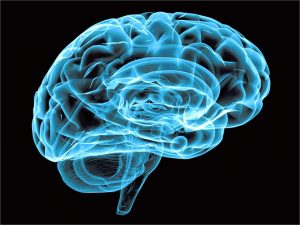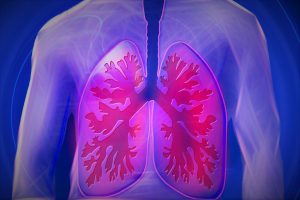We don’t normally have to think about our breathing and that’s because breathing is handled by a subconscious part of the brain called the medulla. The medulla automatically controls our breathing as well as our heart rate and blood pressure (Del Negro et al. 2018). It sends neural signals to the breathing muscles to activate them in order to draw air into our lungs.
But the medulla can be limited in its capacity to activate the breathing muscles. When we need to perform larger breathing manoeuvres, such as sniffing or larger breaths before speech, another part of the brain called the sensorimotor cortex is used (Tremoureux et al. 2014; Hudson et al. 2016). The sensorimotor cortex can provide additional neural signals to the breathing muscles on top of those supplied by the medulla.
In people with chronic obstructive pulmonary disease (COPD), due to tobacco smoke, pollutants or genetic factors, the airways are damaged and the usual function of respiratory system and respiratory muscles is disturbed (Vogelmeier et al. 2017). Thus, the typical output from the medulla may not be enough to drive the breathing muscles at rest. This conclusion is supported by the fact that in other respiratory impairments, such as obstructive sleep apnoea and motoneuron disease, the sensorimotor cortex is used to maintain breathing (Launois et al. 2015; Georges et al. 2016). People with COPD tend to be older and healthy ageing is also associated with degenerative changes to the lungs, rib cage and respiratory muscles although additional involvement of the sensorimotor cortex during breathing in either COPD and or ageing has not been explored previously.
In our recent study (Nguyen et al. 2018), our goal was to determine if the changes to the respiratory system described above in COPD and health ageing are associated with the involvement of the sensorimotor cortex during breathing. We recorded activity of the sensorimotor cortex in resting breathing using electroencephalography. Our study sample consisted of 14 patients with COPD, 16 healthy older adults, and 15 healthy younger adults. Comparisons between patients with COPD and healthy older adults allowed us to investigate the independent effect of COPD on the involvement of the sensorimotor cortex during breathing whereas comparisons between healthy older adults and healthy younger adults allowed us to investigate the influence of healthy ageing.
WHAT DID WE FIND?
Participants with COPD and healthy older people had a higher incidence of sensorimotor cortex activation during breathing (43% and 38% respectively) than healthy young people, who had sensorimotor cortex activation. Furthermore, within the COPD and healthy older groups, those with breathing-related sensorimotor cortical activity were, on average, 10 years older, than those without breathing-related sensorimotor cortical activity (75 vs. 65 years of age respectively).
SIGNIFICANCE AND IMPLICATIONS
Our results showed that older age alone is associated with elevated activity of the sensorimotor cortex during resting breathing. Cortical activity is diminished during most stages of sleep. Therefore, those older people who have sensorimotor cortical activity for breathing during wakefulness may experience hypoventilation during sleep or sleep disturbance when the sensorimotor cortex cannot be recruited for breathing.
PUBLICATION REFERENCE
Nguyen DAT, Boswell-Ruys CL, McBain RA, Eckert DJ, Gandevia SC, Butler JE, Hudson AL. Inspiratory pre‐motor potentials during quiet breathing in ageing and chronic obstructive pulmonary disease. J Physiol. doi: 10.1113/JP275764.
If you cannot access the paper, please click here to request a copy.
KEY REFERENCES
Del Negro CA, Funk GD, Feldman JL. Breathing matters. Nat Rev Neurosci 19: 351-367, 2018.
Georges M, Morawiec E, Raux M, Gonzalez-Bermejo J, Pradat P, Similowski T, Morélot-Panzini C. Cortical drive to breathe in amyotrophic lateral sclerosis: a dyspnoea-worsening defence? Eur Respir J 47: 1818-1828, 2016.
Hudson AL, Navarro-Sune X, Martinerie J, Pouget P, Raux M, Chavez M, Similowski T. Electroencephalographic detection of respiratory-related cortical activity in humans: from event-related approaches to continuous connectivity evaluation. J Neurophysiol 115: 2214-2223, 2016.
Launois C, Attali V, Georges M, Raux M, Morawiec E, Rivals I, Arnulf I, Similowski T. Cortical drive to breathe during wakefulness in patients with obstructive sleep apnea syndrome. Sleep 38: 1743-1749, 2015.
Tremoureux L, Raux M, Ranohavimparany A, Morélot-Panzini C, Pouget P, Similowski T. Electroencephalographic evidence for a respiratory-related cortical activity specific of the preparation of prephonatory breaths. Respir Physiol Neurobiol 204, 64-70, 2014.
Vogelmeier CF, Criner GJ, Martinez FJ, Anzueto A, Barnes PJ, Bourbeau J, Celli BR, Chen R, Decramer M, Fabbri LM. Global strategy for the diagnosis, management, and prevention of chronic obstructive lung disease 2017 report. GOLD executive summary. Am J Respir Crit Care Med 195: 557-582, 2017.
AUTHOR BIO
 David Nguyen is a PhD candidate at NeuRA and the University of New South Wales. His research focuses on the control of breathing.
David Nguyen is a PhD candidate at NeuRA and the University of New South Wales. His research focuses on the control of breathing.

